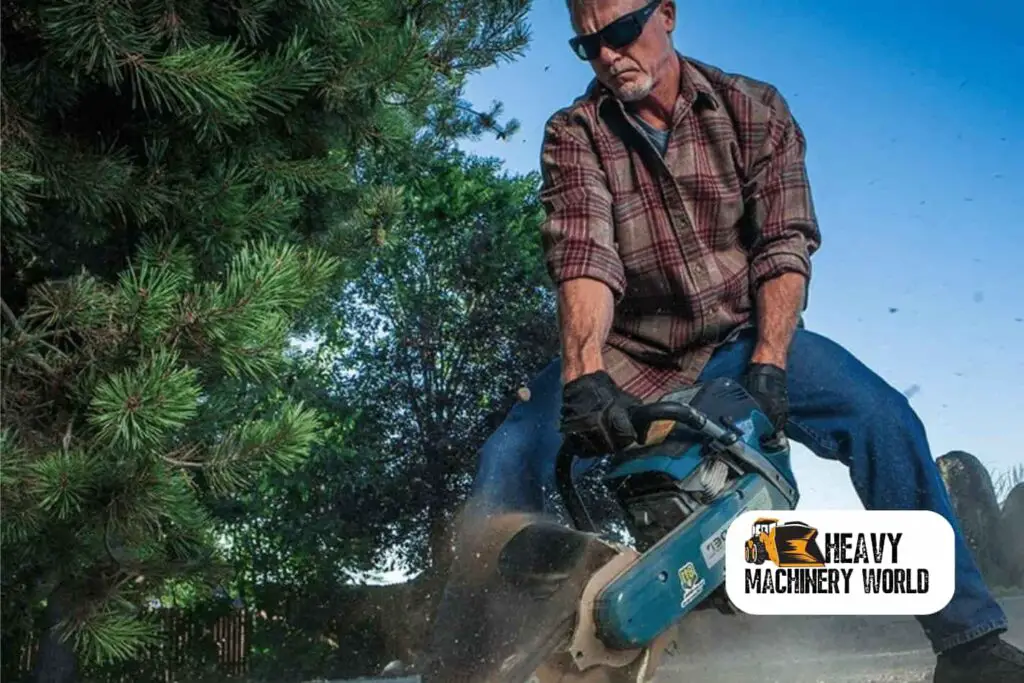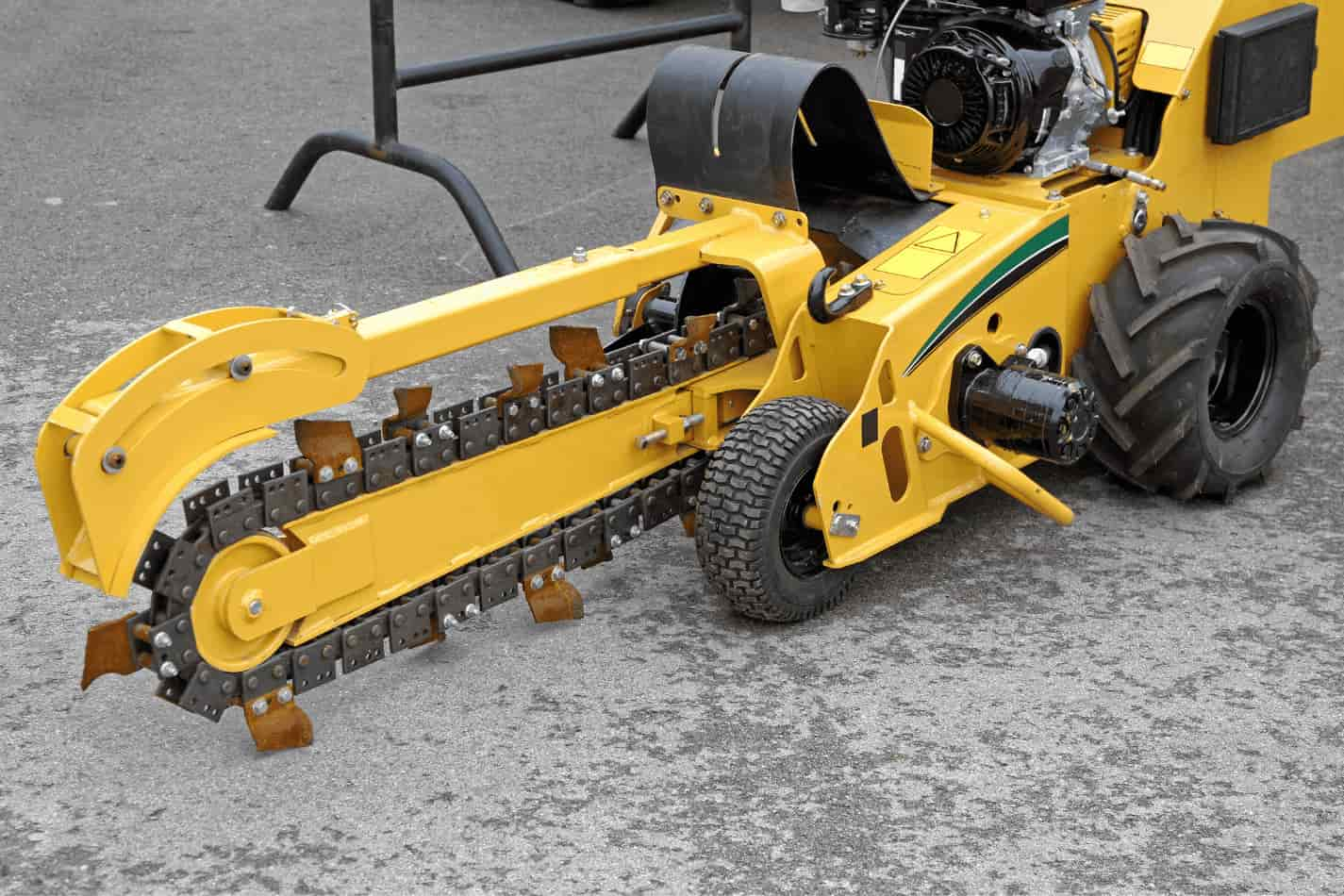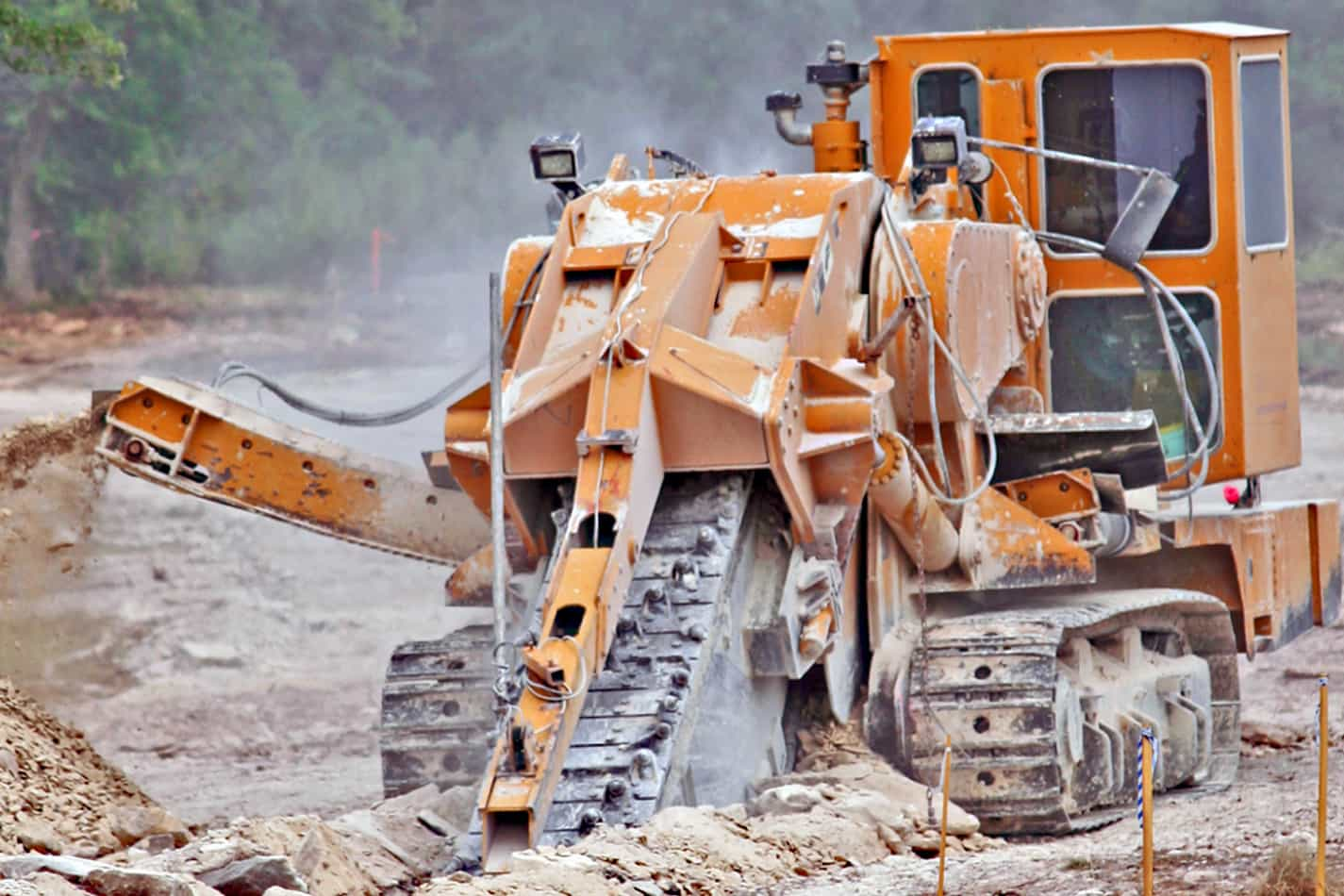If you’re planning on digging trenches for your next project, you may be wondering if a trencher will work in wet ground. The answer isn’t always straightforward, but as an excavation expert, I’ve got some insights to share.
First and foremost, it’s important to understand that the success of using a trencher in wet ground depends on a variety of factors. These include the type of soil you’re working with, the depth and width of the trench you need to dig, and the amount of water present in the area.
Keep reading to learn more about what to consider before deciding whether or not a trencher is the right tool for your wet ground excavation needs.

Understanding Soil Composition
As a groundworks/excavation expert, I have been asked numerous times if a trencher will work in wet ground. To answer this question, we must first understand the composition of soil.
Soil moisture levels play a crucial role in determining how easily it can be excavated. Wet soil is more challenging to work with than dry soil because it sticks together and becomes more compacted. The higher the moisture content, the more difficult it is to cut through the surface without damaging the surrounding area.
Another factor that affects soil’s excavability is its texture. Soil texture analysis helps us determine how much water it can hold and how well it drains. Different types of soil have different textures, which affect their excavation abilities. For instance, sandy soils are easier to excavate than clay soils because they are less cohesive and do not stick together as much.
Understanding these factors helps us decide whether a trencher will work in wet ground. It is possible to use a trencher in wet conditions, but several precautions must be taken to avoid damage or accidents. We will discuss these measures in further detail in the next section.
Assessing Depth And Width Requirements
Understanding soil composition is crucial to determine the right equipment for excavation. One of the most common tools used in trenching is a trencher, but will it work in wet ground? The answer is not straightforward, and it depends on various factors.
Firstly, it’s essential to assess the type of soil in the area. If the ground has high clay content, it can become sticky and challenging to dig through when wet. In such cases, using a trencher may not be practical as it can cause damage to the machine or become ineffective. On the other hand, if the soil has sandy or loamy texture, a trencher may work well even in damp conditions.
Equipment maintenance is critical when working with machinery like trenchers. Wet conditions can increase wear and tear on moving parts of the machine leading to breakdowns or malfunctions. Regular checks on hydraulic fluids, engine oil levels, and air filters are vital to keep your equipment running smoothly. Safety precautions should also be taken seriously by operators while working with a trencher in wet conditions.
Assessing depth and width requirements is another factor to consider before using a trencher in wet ground. The depth and width requirements for a project may vary depending on factors such as pipe size or cable routing needs. However, if the soil saturation level is too high or waterlogged during excavation, utilizing alternative methods may be necessary.
Always prioritize safety while making these decisions to avoid hazards that could occur due to unstable soil conditions.
Remember that proper planning and preparation are key when deciding whether a trencher will work in wet ground conditions. With proper equipment maintenance and safety measures in place, you can efficiently utilize a trencher for excavation projects even in damp environments without compromising results or causing damage to your equipment.
Evaluating Water Saturation Levels
I’d recommend doing a water test and soil sample to get an accurate evaluation of the water saturation levels.
That way, we can be sure of what kind of conditions we’re dealing with and if a trencher will be able to work in the wet ground.
The water test will tell us how much moisture is in the soil, while the soil sample will give us an idea of the type of soil and its stability.
Once we have that information, we can make an informed decision about the best approach.
Water Tests
As an excavation expert, one of the most frequently asked questions I receive is whether trenchers can work in wet ground. The answer to that largely depends on the water saturation level of the soil. To accurately determine this, we conduct water tests on the site.
Water tests are essential in evaluating water saturation levels, which is a critical factor when it comes to soil stability. It helps us determine whether or not the soil can withstand heavy equipment and avoid accidents or damage during excavation work. We also use these tests to identify areas of high saturation and adjust our excavation methods accordingly.
In addition to soil stability concerns, we also need to consider equipment maintenance issues when working in wet ground conditions. Heavy machinery like trenchers may be prone to wear and tear due to prolonged exposure to moisture.
By conducting water tests before starting any project, we can minimize potential damage and ensure that our equipment remains in top shape throughout the excavation process.
Soil Samples
Now that we’ve discussed the importance of preparation and how water tests help us evaluate water saturation levels, let’s talk about another crucial aspect of excavation work – soil samples.
Soil samples are an essential tool in determining the type of soil present on a site. By taking small samples from various points around the excavation area, we can analyze the soil composition and determine its strength and stability. This information is crucial in designing the excavation plan and selecting the appropriate equipment to use.
Another advantage of taking soil samples is that it helps us identify any potential hazards that may affect trenching efficiency. For example, if we find areas with high clay content, we know that they will be more difficult to excavate compared to areas with sandy or gravelly soils. With this information, we can adjust our excavation methods accordingly to ensure maximum efficiency while minimizing the risk of accidents or damage to equipment.
In conclusion, conducting water tests and taking soil samples are two critical steps in evaluating water saturation levels and ensuring a successful excavation project. By doing so, we can avoid potential hazards, select appropriate equipment, and maximize trenching efficiency while maintaining safety standards on-site.
Choosing The Right Trencher For The Job
When it comes to choosing the right trencher for a job, there are several factors to consider. One of the most important factors is the size of the trencher. The size of the machine will depend on the width and depth of the trench required for the project. It’s essential to choose a trencher that can handle the size of the job without causing unnecessary damage to surrounding areas.
Another crucial factor to consider when selecting a trencher is soil moisture. If you’re working in wet ground, it’s crucial to choose a machine that can handle these conditions. Wet soil can be challenging to work with and can cause delays if you don’t have the right equipment. A good rule of thumb is to choose a trencher that is specifically designed for use in wet or damp conditions.
When selecting a trencher, it’s essential to take into account other factors such as soil type, accessibility, and any potential obstacles.
By carefully considering all these factors, you’ll be able to select a machine that can handle any challenge thrown its way and complete your project safely and efficiently.
- Trencher Size
- Consider width and depth requirements for project.
- Choose a machine that can handle the size of job without damaging surrounding areas.
- Ensure adequate power output for desired digging rate.
- Soil Moisture
- Wet soil can be challenging to work with.
- Select a machine that is specifically designed for use in wet or damp conditions.
- Adequate traction and digging capabilities are necessary for optimal performance.
- Other considerations
- Evaluate soil type (rocky, sandy) before selecting equipment.
- Accessibility may require smaller or more maneuverable machines.
- Be prepared for potential obstacles like underground utilities or tree roots.
Choosing the right trencher requires careful consideration of several key factors beyond just size and price point. Soil moisture is one such factor which must be taken into account before making a decision. By choosing a machine that is designed to handle wet or damp conditions, you’ll be able to complete your project safely and efficiently, without causing unnecessary damage to surrounding areas.
Remember to evaluate other factors such as soil type, accessibility, and potential obstacles before selecting equipment to ensure that you have the right machine for the job at hand.
Can Seed Cleaning Equipment Be Used in Wet Conditions?
Seed cleaning machines are designed to handle various conditions, including wet environments. These specialized equipment have features like adjustable air flow and screens that can effectively remove debris, moisture, and impurities from seeds. With proper maintenance and precautions, seed cleaning machines can deliver consistent results even in wet conditions, ensuring high-quality seeds for farmers and growers.
Tips For Successful Trenching In Wet Ground
Just like a fish out of water, using the wrong trencher in wet ground can be disastrous. As an excavation expert, it’s crucial to understand that not all trenchers are created equal. While some may work well in dry or loose soil, they may struggle in damp or muddy conditions.
However, with the right knowledge and equipment, trenching in wet ground can be successful.
Soil stability is a major concern when trenching in wet ground. The moisture content of the soil affects its strength and ability to support heavy machinery. Failure to assess this can lead to dangerous situations such as cave-ins or equipment sinking into the mud. Before starting any excavation work, it’s important to test the soil’s stability and take proper precautions such as shoring up trenches and using appropriate safety gear.
Equipment maintenance is also crucial when working in wet conditions. Mud and moisture can quickly cause wear and tear on machinery which could result in costly repairs or injuries. Daily checks on equipment should be performed before starting work including cleaning off any debris or mud from tracks or wheels, checking hydraulic fluid levels, and inspecting for any damage or leaks.
By carefully selecting the right trencher for the job and taking necessary precautions such as assessing soil stability and maintaining equipment regularly, successful trenching in wet ground is achievable. As an excavation expert, it’s your responsibility to ensure safe practices are followed on every job site for both workers’ safety and efficient completion of projects.
Frequently Asked Questions
Can A Trencher Be Used In Flooded Areas?
When it comes to flooded areas, a trencher may not be the most practical excavation tool.
Trencher limitations include difficulty in maneuvering and potential damage to the machine in excessively wet conditions.
As an excavation expert, I would recommend alternative methods such as hydro-excavation or hand digging to avoid any potential hazards.
These methods allow for greater precision and control while also minimizing environmental impact.
It’s important to consider the specific needs of each project and determine the best excavation method accordingly.
How Does Soil Type Affect Trenching In Wet Conditions?
Soil type plays a crucial role in trenching, especially in wet conditions.
Did you know that soil compaction can increase by up to 20% in wet soils?
This means that trenching can become more challenging and time-consuming, as the soil becomes harder to penetrate.
To alleviate this issue, drainage solutions should be considered to help keep the soil dry and workable.
These solutions may include installing French drains or using sump pumps to remove excess water from the site.
As an excavation expert, I recommend considering these options before beginning any trenching project in wet conditions.
Is It Safe To Operate A Trencher In Wet And Muddy Conditions?
When it comes to trenching in wet and muddy conditions, safety should always be a top priority.
Trencher stability is key in preventing accidents and ensuring the job is done correctly.
Ground preparation is also crucial before operating a trencher in these conditions.
It’s important to assess the soil type and any potential obstacles that may cause issues during the excavation process.
While it’s possible to use a trencher in wet ground, precautions should be taken to ensure the safety of workers and equipment.
By properly preparing the ground and selecting an appropriate trencher, you can successfully complete your project without compromising safety or efficiency.
Can Trenching In Wet Ground Cause Soil Erosion?
Hey there, fellow diggers!
As we all know, trenching in wet ground can be a tricky business. Not only do you have to worry about wet soil stability, but preventing erosion is also key.
To prevent erosion, it’s important to use proper techniques and equipment when digging trenches in wet soil. One way to do this is by using erosion control blankets or straw wattles around the trench site. These materials help stabilize the soil and prevent sediment from washing away during heavy rains or storms.
Remember, taking extra precautions like these can save you time and headaches down the road!
What Are The Best Practices For Maintaining A Trencher In Wet Conditions?
To maintain a trencher in wet conditions, it’s important to follow specific cleaning procedures and lubrication techniques.
Firstly, after every use in wet ground, the machine should be thoroughly cleaned to remove any mud or debris that may have accumulated. This will prevent corrosion and ensure that the parts continue to function properly.
Additionally, special attention should be given to lubricating the moving parts of the trencher. Water can wash away grease and oil, so it’s important to use high-quality lubricants that are specifically designed for wet conditions.
By following these best practices, you’ll ensure that your trencher remains in top condition even when working in challenging environments.
Conclusion
As a groundworks expert, I can confidently say that using a trencher in wet ground is possible but requires careful consideration.
Soil type plays a crucial role in trenching in wet conditions, as some soils are more prone to becoming waterlogged and unstable than others. Before beginning any excavation work, it’s essential to assess the soil type and moisture levels to determine whether it’s safe to use a trencher.
Operating a trencher in wet ground can be hazardous, as muddy and slippery conditions increase the risk of accidents. It’s vital to take extra precautions, such as wearing appropriate personal protective equipment and ensuring that the trencher is well-maintained.
Additionally, trenching in wet ground can cause soil erosion, which can lead to long-term damage to the surrounding environment. Therefore, it’s important to follow best practices for maintaining a trencher in wet conditions and taking steps to prevent soil erosion.
Overall, while using a trencher in wet ground can be challenging, it’s not impossible with proper planning and execution. As an excavation expert, I advise that anyone considering using a trencher in these conditions should take all necessary precautions and follow best practices for maintaining equipment and protecting the surrounding environment from damage.
With care and attention to detail, we can safely excavate even the muddiest of grounds!




